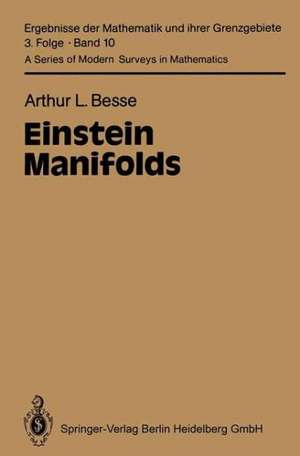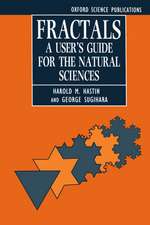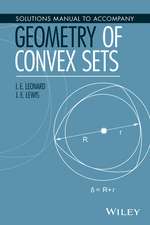Einstein Manifolds: Classics in Mathematics
Autor Arthur L. Besseen Limba Engleză Paperback – 3 dec 2007
Din seria Classics in Mathematics
-
 Preț: 404.18 lei
Preț: 404.18 lei -
 Preț: 428.05 lei
Preț: 428.05 lei -
 Preț: 400.47 lei
Preț: 400.47 lei -
 Preț: 404.34 lei
Preț: 404.34 lei -
 Preț: 402.27 lei
Preț: 402.27 lei -
 Preț: 422.11 lei
Preț: 422.11 lei -
 Preț: 438.87 lei
Preț: 438.87 lei -
 Preț: 431.56 lei
Preț: 431.56 lei -
 Preț: 425.80 lei
Preț: 425.80 lei -
 Preț: 429.61 lei
Preț: 429.61 lei -
 Preț: 421.72 lei
Preț: 421.72 lei -
 Preț: 425.80 lei
Preț: 425.80 lei -
 Preț: 422.90 lei
Preț: 422.90 lei -
 Preț: 427.49 lei
Preț: 427.49 lei -
 Preț: 421.17 lei
Preț: 421.17 lei -
 Preț: 415.39 lei
Preț: 415.39 lei -
 Preț: 485.07 lei
Preț: 485.07 lei -
 Preț: 437.72 lei
Preț: 437.72 lei -
 Preț: 444.47 lei
Preț: 444.47 lei -
 Preț: 440.39 lei
Preț: 440.39 lei -
 Preț: 447.73 lei
Preț: 447.73 lei -
 Preț: 438.10 lei
Preț: 438.10 lei -
 Preț: 509.50 lei
Preț: 509.50 lei -
 Preț: 418.83 lei
Preț: 418.83 lei -
 Preț: 436.74 lei
Preț: 436.74 lei -
 Preț: 446.37 lei
Preț: 446.37 lei -
 Preț: 430.59 lei
Preț: 430.59 lei -
 Preț: 421.93 lei
Preț: 421.93 lei -
 Preț: 429.06 lei
Preț: 429.06 lei -
 Preț: 431.56 lei
Preț: 431.56 lei -
 Preț: 457.36 lei
Preț: 457.36 lei -
 Preț: 429.99 lei
Preț: 429.99 lei -
 Preț: 504.66 lei
Preț: 504.66 lei -
 Preț: 433.31 lei
Preț: 433.31 lei -
 Preț: 418.07 lei
Preț: 418.07 lei -
 Preț: 428.07 lei
Preț: 428.07 lei -
 Preț: 427.33 lei
Preț: 427.33 lei -
 Preț: 425.80 lei
Preț: 425.80 lei -
 Preț: 438.26 lei
Preț: 438.26 lei -
 Preț: 408.61 lei
Preț: 408.61 lei -
 Preț: 432.51 lei
Preț: 432.51 lei -
 Preț: 429.61 lei
Preț: 429.61 lei -
 Preț: 435.20 lei
Preț: 435.20 lei -
 Preț: 428.68 lei
Preț: 428.68 lei -
 Preț: 437.12 lei
Preț: 437.12 lei -
 Preț: 438.69 lei
Preț: 438.69 lei
Preț: 437.50 lei
Nou
Puncte Express: 656
Preț estimativ în valută:
83.71€ • 87.40$ • 69.29£
83.71€ • 87.40$ • 69.29£
Carte tipărită la comandă
Livrare economică 05-19 aprilie
Preluare comenzi: 021 569.72.76
Specificații
ISBN-13: 9783540741206
ISBN-10: 3540741208
Pagini: 528
Ilustrații: XII, 510 p.
Dimensiuni: 155 x 235 x 28 mm
Greutate: 0.8 kg
Ediția:Reprint of the 1st ed. Berlin Heidelberg New York 1987
Editura: Springer Berlin, Heidelberg
Colecția Springer
Seria Classics in Mathematics
Locul publicării:Berlin, Heidelberg, Germany
ISBN-10: 3540741208
Pagini: 528
Ilustrații: XII, 510 p.
Dimensiuni: 155 x 235 x 28 mm
Greutate: 0.8 kg
Ediția:Reprint of the 1st ed. Berlin Heidelberg New York 1987
Editura: Springer Berlin, Heidelberg
Colecția Springer
Seria Classics in Mathematics
Locul publicării:Berlin, Heidelberg, Germany
Public țintă
ResearchCuprins
Basic Material.- Basic Material (Continued): Kähler Manifolds.- Relativity.- Riemannian Functionals.- Ricci Curvature as a Partial Differential Equation.- Einstein Manifolds and Topology.- Homogeneous Riemannian Manifolds.- Compact Homogeneous Kähler Manifolds.- Riemannian Submersions.- Holonomy Groups.- Kähler-Einstein Metrics and the Calabi Conjecture.- The Moduli Space of Einstein Structures.- Self-Duality.- Quaternion-Kähler Manifolds.- A Report on the Non-Compact Case.- Generalizations of the Einstein Condition.
Recenzii
From the reviews:
"[...] an efficient reference book for many fundamental techniques of Riemannian geometry. [...] despite its length, the reader will have no difficulty in getting the feel of its contents and discovering excellent examples of all interaction of geometry with partial differential equeations, topology, and Lie groups. Above all, the book provides a clear insight into the scope and diversity of problems posed by its title."
S.M. Salamon in MathSciNet 1988
"It seemed likely to anyone who read the previous book by the same author, namely Manifolds all of whose geodesic are closed, that the present book would be one of the most important ever published on Riemannian geometry. This prophecy is indeed fulfilled."
T.J. Wilmore in Bulletin of the London Mathematical Society 1987
"Einstein Manifolds is accordingly described as Besse’s second book … . there is no doubt that Einstein Manifolds is a magnificient work of mathematical scholarship. … It is truly a seminal work on an incomparably fascinating and important subject." (Michael Berg, MathDL, March, 2008)
"The present book is intended to be a complete reference book. … The book under review serves several purposes. It is an efficient reference for many fundamental techniques of Riemannian geometry as well as excellent examples of the interaction of geometry with partial differential equations, topology and Lie groups. Certainly the monograph provides a clear insight into the scope and diversity of problems posed by its title." (Adela-Gabriela Mihai, Zentralblatt MATH, Vol. 1147, 2008)
"[...] an efficient reference book for many fundamental techniques of Riemannian geometry. [...] despite its length, the reader will have no difficulty in getting the feel of its contents and discovering excellent examples of all interaction of geometry with partial differential equeations, topology, and Lie groups. Above all, the book provides a clear insight into the scope and diversity of problems posed by its title."
S.M. Salamon in MathSciNet 1988
"It seemed likely to anyone who read the previous book by the same author, namely Manifolds all of whose geodesic are closed, that the present book would be one of the most important ever published on Riemannian geometry. This prophecy is indeed fulfilled."
T.J. Wilmore in Bulletin of the London Mathematical Society 1987
"Einstein Manifolds is accordingly described as Besse’s second book … . there is no doubt that Einstein Manifolds is a magnificient work of mathematical scholarship. … It is truly a seminal work on an incomparably fascinating and important subject." (Michael Berg, MathDL, March, 2008)
"The present book is intended to be a complete reference book. … The book under review serves several purposes. It is an efficient reference for many fundamental techniques of Riemannian geometry as well as excellent examples of the interaction of geometry with partial differential equations, topology and Lie groups. Certainly the monograph provides a clear insight into the scope and diversity of problems posed by its title." (Adela-Gabriela Mihai, Zentralblatt MATH, Vol. 1147, 2008)
Notă biografică
Arthur L. Besse
Besides his personal work in Riemannian Geometry, Marcel Berger is well known for his persistent and untiring propaganda for the problems he considers to be (and which actually are) natural and fundamental.
In 1975, he convinced his students to organise a workshop about one of his favorite problems, namely to understand manifolds, all of whose geodesics are closed. The workshop took place in Besse-en-Chandesse, a very pleasant village in the centre of France, and turned out to be so successful that a consensus emerged to write a book about this topic. Arthur Besse was born.
At that time, such a first name seemed old-fashioned and funny in France. But why not ? Besides, the association with King Arthur could not be overlooked, since this type of meeting was denoted, by the CNRS, as a "Table Ronde" !
The experience was so enjoyable that Arthur did not stop there, and settled down to write another book.
A preliminary workshop took place in another village, even lovelier than the first: Espalion, in the South-West of France. This second book, Einstein Manifolds, was eventually published in 1987.
Years have passed. Arthur's friends (the list of which can be found in the beginning of his books) haved scattered to various places.
For Arthur himself, who never laid any claim to immortality, it may be time for retirement.
One FAQ. What do Bourbaki and Besse have in common? Hardly anything. Simply that both are mathematicians, of course, and share a taste for working in pleasant and quiet places.
Besides his personal work in Riemannian Geometry, Marcel Berger is well known for his persistent and untiring propaganda for the problems he considers to be (and which actually are) natural and fundamental.
In 1975, he convinced his students to organise a workshop about one of his favorite problems, namely to understand manifolds, all of whose geodesics are closed. The workshop took place in Besse-en-Chandesse, a very pleasant village in the centre of France, and turned out to be so successful that a consensus emerged to write a book about this topic. Arthur Besse was born.
At that time, such a first name seemed old-fashioned and funny in France. But why not ? Besides, the association with King Arthur could not be overlooked, since this type of meeting was denoted, by the CNRS, as a "Table Ronde" !
The experience was so enjoyable that Arthur did not stop there, and settled down to write another book.
A preliminary workshop took place in another village, even lovelier than the first: Espalion, in the South-West of France. This second book, Einstein Manifolds, was eventually published in 1987.
Years have passed. Arthur's friends (the list of which can be found in the beginning of his books) haved scattered to various places.
For Arthur himself, who never laid any claim to immortality, it may be time for retirement.
One FAQ. What do Bourbaki and Besse have in common? Hardly anything. Simply that both are mathematicians, of course, and share a taste for working in pleasant and quiet places.
Textul de pe ultima copertă
From the reviews:
"[...] an efficient reference book for many fundamental techniques of Riemannian geometry. [...] despite its length, the reader will have no difficulty in getting the feel of its contents and discovering excellent examples of all interaction of geometry with partial differential equations, topology, and Lie groups. Above all, the book provides a clear insight into the scope and diversity of problems posed by its title."
S.M. Salamon in MathSciNet 1988
"It seemed likely to anyone who read the previous book by the same author, namely "Manifolds all of whose geodesic are closed", that the present book would be one of the most important ever published on Riemannian geometry. This prophecy is indeed fulfilled."
T.J. Wilmore in Bulletin of the London Mathematical Society 1987
"[...] an efficient reference book for many fundamental techniques of Riemannian geometry. [...] despite its length, the reader will have no difficulty in getting the feel of its contents and discovering excellent examples of all interaction of geometry with partial differential equations, topology, and Lie groups. Above all, the book provides a clear insight into the scope and diversity of problems posed by its title."
S.M. Salamon in MathSciNet 1988
"It seemed likely to anyone who read the previous book by the same author, namely "Manifolds all of whose geodesic are closed", that the present book would be one of the most important ever published on Riemannian geometry. This prophecy is indeed fulfilled."
T.J. Wilmore in Bulletin of the London Mathematical Society 1987
Caracteristici
Includes supplementary material: sn.pub/extras












